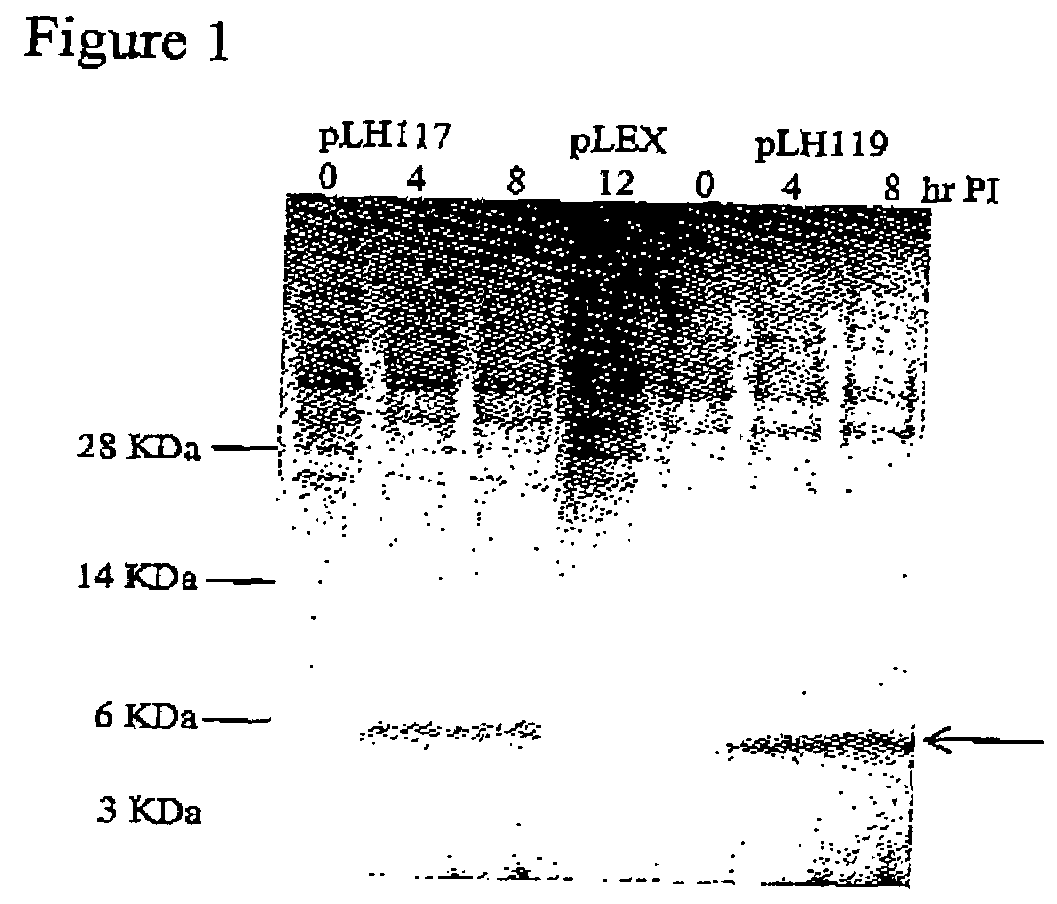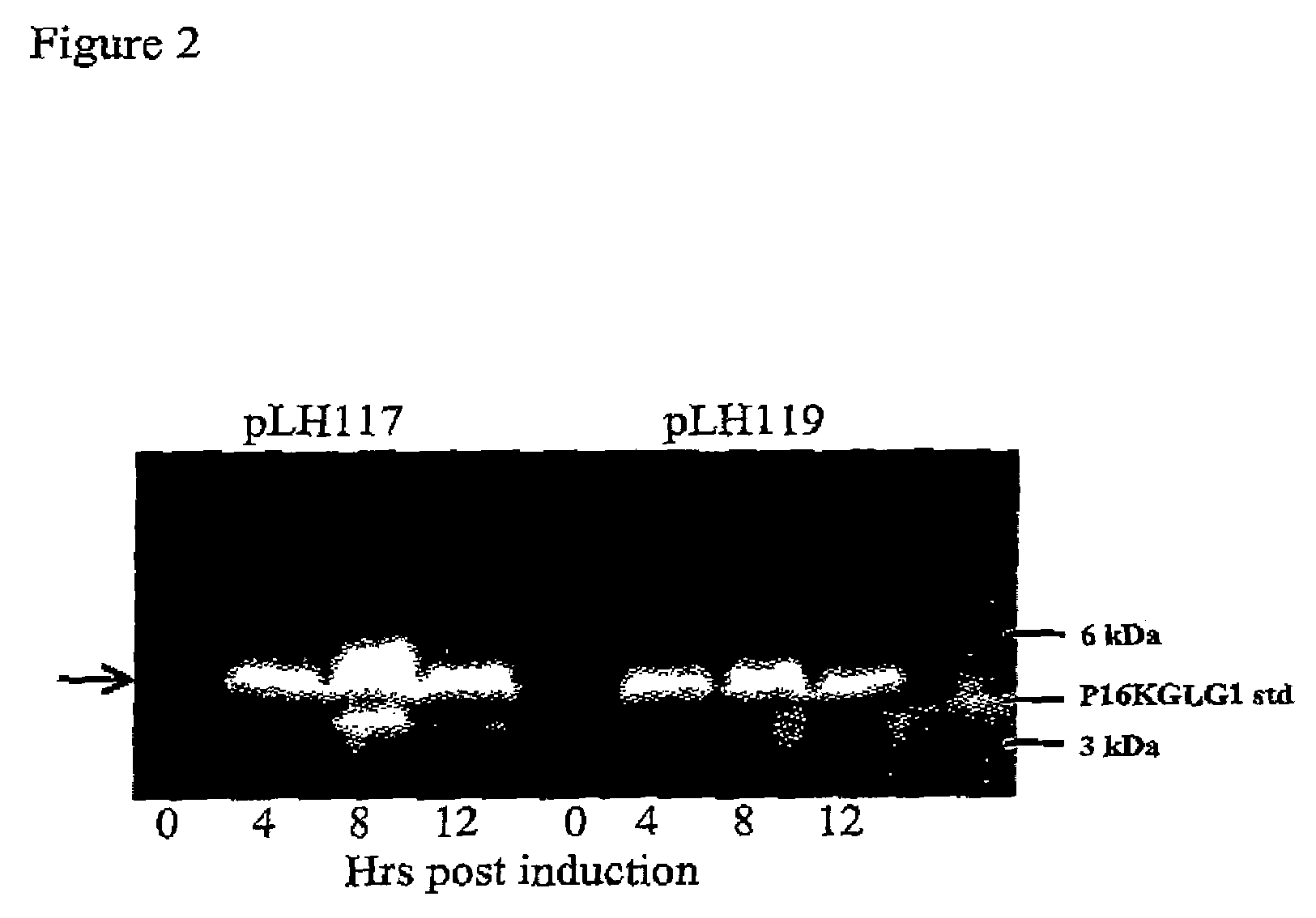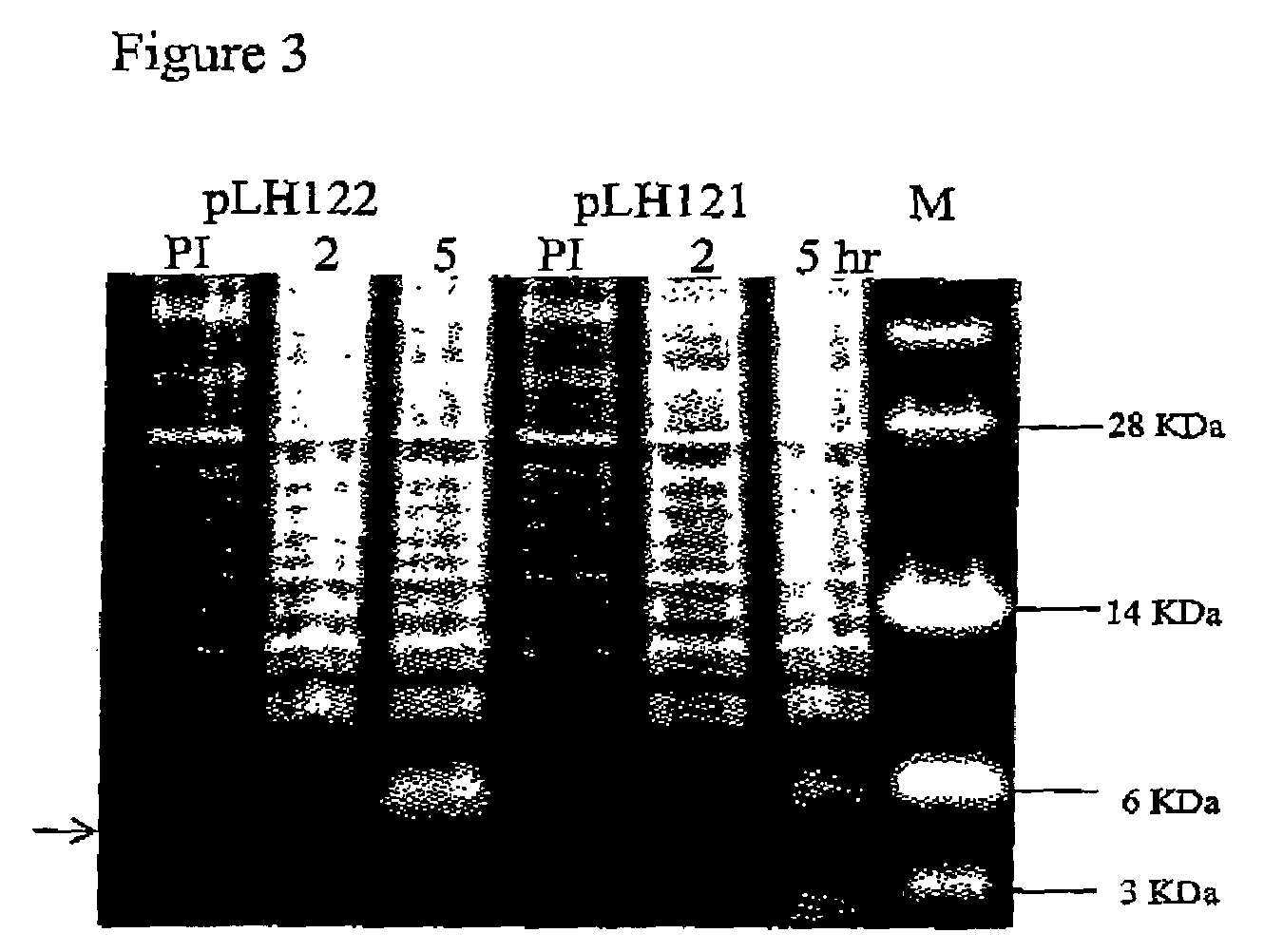Process for recombinant expression and purification of antimicrobial peptides using periplasmic targeting signals as precipitable hydrophobic tags
a technology of antimicrobial peptides and precipitation tags, which is applied in the field of recombinant production of antimicrobial peptides, can solve the problems of limited production and cell death, toxic effects, and difficulty in expressing short polypeptide chains
- Summary
- Abstract
- Description
- Claims
- Application Information
AI Technical Summary
Problems solved by technology
Method used
Image
Examples
example 1
Construction of a Chimeric Gene Encoding a Fusion Protein of the Periplasmic Targeting Signal from OmpA with an Antimicrobial Peptide
[0157]A DNA fragment containing the OmpA signal peptide coding sequence (SEQ ID NO:11) fused to the 16KGLG1 antimicrobial peptide coding sequence (SEQ ID NO:8) and a 6His coding sequence was synthesized in an annealing reaction using the oligonucleotide primers: SEQ ID NOs:17-22. For ligations, internal primers were 5′ phosphorylated. One nmol of each primer was combined and heated to 90° C. for 5 min and allowed to cool slowly (in heat block) to RT in order to allow slow annealing of the overlap regions. When cool, 1× Ligase buffer and 20 units of ligase were added to the primer mix. The ligation mix was incubated overnight at 4° C.
PCR Amplification:
[0158]One μl of the ligation reaction was used in a PCR reaction with 25 pmol of each primer, SEQ ID NOs:23 and 24. The primers were reconstituted in ddH2O to a working concentration of 5 pmoles / μl. The PC...
example 2
Construction of a Chimeric Gene Encoding a Fusion Protein of the Periplasmic Targeting Signal from GeneIII and an Antimicrobial Peptide
[0165]A DNA fragment containing the GeneIII targeting signal sequence peptide (GeneIIISS) coding sequence (SEQ ID NO:10) fused to the 16KGLG1 antimicrobial peptide coding sequence (SEQ ID NO:8) and a 6His coding sequence was synthesized in a PCR amplification reaction using the following oligonucleotide primers: SEQ ID NOs:28-31. The primers were reconstituted in ddH2O to a working concentration of 5 pmoles / μl.
PCR Amplification:
[0166]The first round of PCR consisted of 10 pmoles of each of the primers (SEQ ID NOs:28-31), 1×Pfu polymerase buffer (Invitrogen), 0.4 mM dNTPs, and 2 units Pfu polymerase in a 50 μl reaction. A Perkin Elmer thermocycler GENEAMP PCR system 9700 (Perkin Elmer Applies Biosystems; Branchburg, Va.) was used to incubate the reaction as follows: two cycles of 94° C. melting for 30 sec followed by 46° C. annealing for 30 sec follow...
example 3
Induction of Expression of the Targeting Signal Sequence-16KGLG1-6His Fusion Proteins Using the PLEX System
Shake Flask Studies:
[0169]Single colonies of E. coli containing pLH117 or pLH119 were grown in Rich Medium overnight at 30° C. at 250 rpm. A fresh culture was started the following day using 10% of the overnight growth diluted in Induction media and grown to an OD550 of 0.8. Induction media had no tryptophan (1×M9 salts, 0.2% casamino acids, 0.5% glucose, 1 mM MgCl2, and 100 ug / ml ampicillin). To facilitate induction, tryptophan was added for a final concentration of 100 μg / ml and flasks were incubated at 37° C. with shaking at 300 rpm. Samples were taken pre-induction and at 4, 8, and 12 hr post induction. Cell pellets were collected by centrifugation and analyzed for protein production.
[0170]Cells expressing the fusion proteins GeneIII targeting signal sequence-16KGLG1-6His (SEQ ID NO:7) or OmpA targeting signal sequence-16KGLG1-6His (SEQ ID NO:6) grew at similar rates as con...
PUM
| Property | Measurement | Unit |
|---|---|---|
| molecular weight | aaaaa | aaaaa |
| pH | aaaaa | aaaaa |
| temperatures | aaaaa | aaaaa |
Abstract
Description
Claims
Application Information
 Login to View More
Login to View More - R&D
- Intellectual Property
- Life Sciences
- Materials
- Tech Scout
- Unparalleled Data Quality
- Higher Quality Content
- 60% Fewer Hallucinations
Browse by: Latest US Patents, China's latest patents, Technical Efficacy Thesaurus, Application Domain, Technology Topic, Popular Technical Reports.
© 2025 PatSnap. All rights reserved.Legal|Privacy policy|Modern Slavery Act Transparency Statement|Sitemap|About US| Contact US: help@patsnap.com



